Thank you for visiting! By the way… any links on this page that lead to products on Amazon and other stores/partners are affiliate links Aquarium Store Depot earns a commission if you make a purchase.
Large, aggressive fish can make the most amazing pets! That’s exactly why I’ve put together this guide to aggressive freshwater aquarium fish.
Caring for these amazing animals can take a lot of time, space, and some pretty deep pockets too! If you’re ready for the commitment, or just interested in learning more about these legends of the aquarium world, this article is for you.
Let’s dive straight in!
What Are Aggressive Fish?
An aggressive fish is any fish that can cause harm to other members of its own species, other fish species, or even the fish keepers who own them. Some of it comes down to the individual personality of the fish, but certain species are just known for aggression. Aggressive freshwater fish can make great pets, of course, they just need a little extra planning.
Freshwater aquarium fish are usually labeled as peaceful, semi-aggressive, or aggressive. What exactly is the difference though?
Well, there is no clear-cut line between these categories but here’s a simple way to think about it.
- Peaceful fish don’t fight, chase or eat other similar-sized fish in the aquarium
- Semi-aggressive fish can attack and bully other fish in the aquarium under certain circumstances
- Aggressive fish are likely to fight, harass, eat, or kill other fish in the aquarium
15 Of The Best For Aquariums
Now that you know what aggressive fish are, it’s time to meet a few of the most amazing aggressive freshwater aquarium fish that you can keep.
For each fish species in my list, I’ll be providing you with the most important facts that you need to know:
- Scientific Name
- Difficulty Level
- Temperament
- Adult Size
- Minimum Tank Size
- Diet
- Origin
- Temperature
- pH
- Difficulty to breed
- Planted tank suitability
We got a YouTube video from our channel below so you can follow along. We have additional details in our blog, so please view both. If you like our content, be sure to subscribe as we create new video content every week!
After introducing you to 15 amazing species (and 4 to avoid), I’ll be giving you some more background information about what makes these animals tick and how to care for them, so make sure you read to the end!
1. Wolf Cichlid

- Scientific Name: Parachromis dovii
- Difficulty Level: Advanced
- Temperament: Aggressive
- Adult Size: 24-28 inches
- Minimum Tank Size: 200 gallons
- Diet: Carnivorous fish, feed cichlid pellets, frozen foods
- Origin: Costa Rica, Honduras, Nicaragua
- Temperature: 75-81°F
- pH: 6.8-7.6
- Difficulty to breed: Advanced
- Planted tank suitability: No
The new world cichlids are some of the coolest aggressive aquarium fish in the hobby, and the wolf cichlid is a perfect example. These aggressive cichlids are very aware of their surroundings and always seem to be watching their owners.
These voracious feeders are partially piscivorous, which means they feed on other fish. They are best kept in a species-only tank, although some brave monster fish keepers have kept them with tank mates. This is one mean fish!
2. Jaguar Cichlid

- Scientific Name: Parachromis managuensis
- Difficulty Level: Moderate
- Temperament: Aggressive
- Adult Size: 10-16 inches
- Minimum Tank Size: 100 gallons
- Diet: Carnivorous fish, feed cichlid pellets, frozen foods
- Origin: Costa Rica, Honduras, Nicaragua
- Temperature: 73-81°F
- pH: 7-8.5
- Difficulty to breed: Moderate
- Planted tank suitability: No
Jaguar cichlids are a smaller relative of the wolf cichlid above. These beautiful fish are amazingly marked with spotted patterns just like their big-cat namesakes.
Jaguar cichlids have an aggressive nature and they are armed with powerful jaws, and sharp teeth to back it up. These fish can be kept alone or with other large cichlid tank mates that can hold their own.
3. Red Devil Cichlid
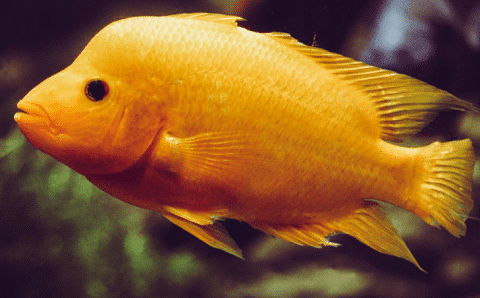
- Scientific Name: Amphilophus labiatus
- Difficulty Level: Moderate
- Temperament: Aggressive
- Adult Size: 12-15 inches
- Minimum Tank Size: 55 gallons
- Diet: Omnivorous fish, feed cichlid pellets, vegetables, live & frozen foods
- Origin: Nicaragua
- Temperature: 75-79°F
- pH: 6-8
- Difficulty to breed: Moderate
- Planted tank suitability: No
The red devil cichlid owns its name with a serious attitude and awesome orange color. These aggressive cichlids can be just as mean to members of their own species as they can with other tank mates, so the bigger the tank the better.
Red devil cichlids love rearranging their tanks, so be prepared for the ornaments and decoration to be shifted around.
4. Silver Arowana

- Scientific Name: Osteoglossum bicirrhosum
- Difficulty Level: Advanced
- Temperament: Aggressive
- Adult Size: 28-32 inches
- Minimum Tank Size: 200 gallons
- Diet: Carnivorous fish, feed pellets, frozen & live foods
- Origin: Brazil, Peru, Ecuador, Guyana, French Guiana, Columbia
- Temperature: 68-86°F
- pH: 6-7.5
- Difficulty to breed: Advanced
- Planted tank suitability: No
The silver Arowana is a true monster fish that very few aquarists have the space to keep. These fish grow to nearly 3 feet long, and they are serious jumpers.
This means they need a huge aquarium that is more secure than a maximum-security prison! Arowanas are predators with big mouths, so don’t keep them with any small tank mates.
5. Texas Cichlid
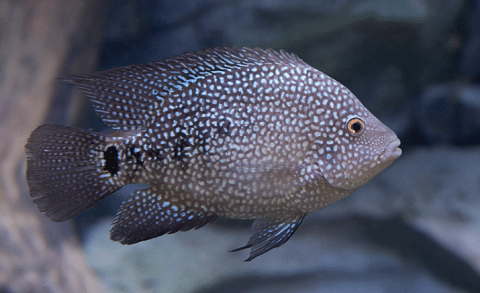
- Scientific Name: Herichthys cyanoguttatus
- Difficulty Level: Moderate
- Temperament: Aggressive
- Adult Size: 10-12 inches
- Minimum Tank Size: 75 gallons
- Diet: Omnivorous fish, feed pellets, frozen & live foods, vegetables
- Origin: USA & Mexico
- Temperature: 70-75°F
- pH: 6.5-7.5
- Difficulty to breed: Advanced
- Planted tank suitability: No
They say everything’s bigger in Texas, and Texas cichlids have huge personalities and appetites to match. These awesome fish are not fussy when it comes to feeding and actually make a good fish for aquarists looking to start out with aggressive species.
Texas cichlids are the only cichlid species native to the United States. The males are larger and more aggressive than the females, but both have incredible black and iridescent blue speckled bodies.
6. Oscar

- Scientific Name: Astronotus ocellatus
- Difficulty Level: Moderate
- Temperament: Aggressive
- Adult Size: 10-14 inches
- Minimum Tank Size: 55 gallons
- Diet: Omnivorous fish, feed pellets & live/frozen foods
- Origin: South America
- Temperature: 68-82°F
- pH: 6-7.5
- Difficulty to breed: Moderate
- Planted tank suitability: No
Oscar fish make great pets for experienced aquarists and can live for up to 20 years with the right care. They have big personalities and love begging for food. These South American cichlids can be pretty mean, and won’t hesitate to eat any smaller tank mates.
Oscar fish come in a few different varieties with body colors varying from white through black, red, and even green. Long-finned oscar fish varieties are also available.
7. Jack Dempsey
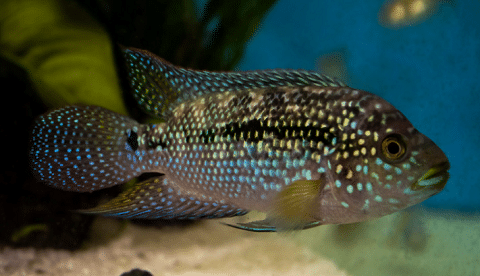
- Scientific Name: Rocio octofasciata
- Difficulty Level: Easy
- Temperament: Semi-aggressive
- Adult Size: 6-8 inches
- Minimum Tank Size: 55 gallons
- Diet: Omnivorous fish, feed pellets, live/frozen food, & vegetables
- Origin: Honduras, Guatemala, Belize, Mexico
- Temperature: 68-86°F
- pH: 6.5-8
- Difficulty to breed: Moderate
- Planted tank suitability: Floating plants and epiphytes
The Jack Dempsey cichlid is named after a famous American boxer. These fish don’t necessarily live up to their name, however, and they can even be pretty shy.
As a single specimen, they are not too aggressive to form part of a community tank, but careful planning is definitely needed. If kept in a group, these new world cichlids can be very aggressive with each other once mature.
8. Red Tail Catfish

- Scientific Name: Phractocephalus hemioliopterus
- Difficulty Level: Advanced
- Temperament: Semi-aggressive
- Adult Size: 3-4 feet
- Minimum Tank Size: 2000 gallons
- Diet: Omnivorous fish
- Origin: South America
- Temperature: 70-79°F
- pH: 6-7.5
- Difficulty to breed: Advanced
- Planted tank suitability: Yes
The red-tail catfish is a truly awesome fish, but sadly, most of them never end up in the right home. The problem is that these fish grow huge, and few aquarists have the space and money for a big enough aquarium. Redtail catfish have been recorded at over 80 lbs and nearly 4.5 feet!
With the right kind of setup, these exotic catfish can make amazing pets. They are not aggressive towards other species, but they grow huge and have big mouths, which means smaller tank mates will disappear pretty soon. They can, however, be aggressive toward each other so it’s best to keep just one in a tank.
9. Vampire
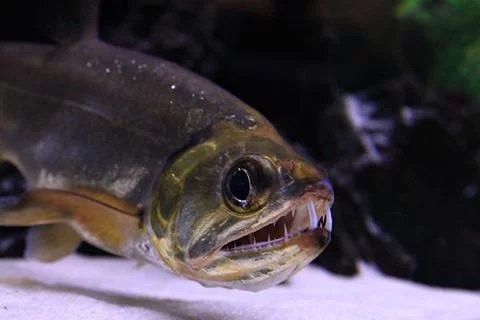
- Scientific Name: Hydrolycus scomberoides
- Difficulty Level: Advanced
- Temperament: Semi-aggressive
- Adult Size: 10-12 inches
- Minimum Tank Size: 250 gallons
- Diet: Carnivorous fish, feed live fish
- Origin: Brazil, Peru, Ecuador, Bolivia
- Temperature: 75-82°F
- pH: 6-8
- Difficulty to breed: Advanced
- Planted tank suitability: No
The vampire fish, or vampire tetra, sounds like something straight out of a horror movie. These silvery streamlined predators are at home in flowing water, so a tank with strong filtration is recommended.
They are shoaling fish when young, but become more solitary when older. These fish jump too, so a secure lid is essential. Vampire fish aren’t actually aggressive with larger fish but they do have huge teeth and feed on surprisingly large prey. This makes choosing tank mates pretty tricky.
10. Black Wolf
- Scientific Name: Hoplias curupira
- Difficulty Level: Advanced
- Temperament: Aggressive
- Adult Size: 16-20 inches
- Minimum Tank Size: 200 gallons
- Diet: Carnivorous, feed fish fillets
- Origin: South America
- Temperature: 68-82°F
- pH: 6.8-7.5
- Difficulty to breed: Advanced
- Planted tank suitability: No
It would be very difficult to pick a meaner fish than the black wolf fish (video source). These predators are just plain killers. Black wolf fish have huge mouths and powerful jaws, filled with sharp teeth.
They are nocturnal hunters and tend to spend the day lying still at the bottom of the tank. This is a fish that should only be kept in a species only aquarium.
11. Severums
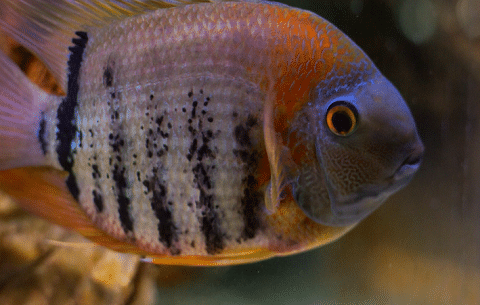
- Scientific Name: Heros efasciatus
- Difficulty Level: Moderate
- Temperament: Semi-aggressive
- Adult Size: 8-10 inches
- Minimum Tank Size: 55 gallons
- Diet: Omnivorous fish, feed pellets, live/frozen foods & vegetables
- Origin: South America
- Temperature: 72-84°F
- pH: 5.5-7
- Difficulty to breed: Moderate
- Planted tank suitability: No
Severums are not all that aggressive, except when breeding time comes around. Keeping a small group of them can reduce aggression, as lone fish can become pretty mean when mature.
Severums come in many amazing color varieties. These South American cichlids are not fussy when it comes to mealtime, and they will happily tear up aquarium plants. It is possible to keep severums with many different types of tank mates as long as they are peaceful and enjoy the same water parameters.
12. Freshwater Stingrays

- Scientific Name: Potamotrygon spp.
- Difficulty Level: Moderate
- Temperament: Semi-aggressive
- Adult Size: 1.5-3 feet across
- Minimum Tank Size: 200 gallons
- Diet: Carnivorous fish, feed pellets, live & frozen foods
- Origin: South America
- Temperature: 75-82°F
- pH: 6.8-7.6
- Difficulty to breed: Advanced
- Planted tank suitability: No
You probably think of the ocean when you think of stingrays, but there are actually some amazing freshwater species that work great in the right kind of aquarium. Stingrays are cartilaginous fish (from the same group as sharks) and these ambush predators have a venomous spine on their tails.
They are actually very docile animals, but the possibility of a sting is always there. Freshwater stingrays need a tank with plenty of floorspace and depth is not all that important.
13. Green Terror Cichlid

- Scientific Name: Andinoacara rivulatus
- Difficulty Level: Moderate
- Temperament: Aggressive
- Adult Size: 8-12 inches
- Minimum Tank Size: 55 gallons
- Diet: Omnivorous fish, feed
- Origin: Peru, Ecuador
- Temperature: 68-75°F
- pH: 6.5-8
- Difficulty to breed: Moderate-advanced
- Planted tank suitability: No
Green terrors are absolutely stunning South American cichlids with amazing turquoise green bodies and black and red fins. The males are much larger than females, and have a very aggressive nature, especially around breeding time.
Keeping one of these fish on its own in a large tank is pretty straightforward, but adding them to community tanks is where things get very tricky. A pair of these fish will attack and kill any other fish when breeding season comes around.
14. Mbu Pufferfish
- Scientific Name: Tetraodon mbu
- Difficulty Level: Advanced
- Temperament: Semi-aggressive
- Adult Size: 24 inches
- Minimum Tank Size: 500 gallons
- Diet: Carnivorous fish, feed mollusks (shellfish)
- Origin: Tanzania, Zambia, DRC, Cameroon, Burundi
- Temperature: 75-79°F
- pH: 7-8
- Difficulty to breed: Advanced
- Planted tank suitability: Possible
The mbu, or giant puffer is a huge African species that can make an amazing pet for the dedicated fish keeper. If you want a large aquatic pet with its own unique personality, this could be the fish for you.
Mbu pufferfish aren’t always aggressive, but they are large, and they do have serious teeth! It is best to keep them on their own or with fast-moving fish in a massive aquarium.
15. Pignose pufferfish

- Scientific Name: Tetraodon suvattii
- Difficulty Level: Moderate
- Temperament: Aggressive
- Adult Size: 6 inches
- Minimum Tank Size: 20 gallons
- Diet: Carnivorous fish, feed live foods
- Origin: Laos, Thailand
- Temperature: 72-79°F
- pH: 6.5-7.5
- Difficulty to breed: Advanced
- Planted tank suitability: Yes
The pignose or arrowhead puffer is a really cool and unique freshwater aquarium fish. These puffers are serious ambush predators that spend their time on the bottom, blending in with their amazing camouflage. If a small fish should swim by, it will be swallowed up before it even knows what hit it.
This behavior means they aren’t very active pets, but they are awesome for aquarists looking for a rare and unusual aggressive fish species. They should only be kept on their own because they will eat anything smaller than themselves, and bite chunks out of tankmates that are too big to swallow.
Fish To Avoid
The following fish are species that many aquarists dream of keeping because they’re just so cool. Theoretically, with a large enough tank, you could keep any fish, but the fish on this list aren’t great choices. Read on to learn why…
1. Piranhas
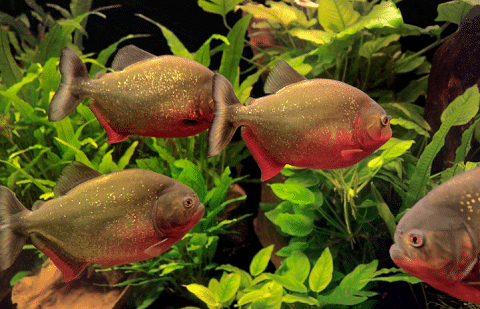
Sure, piranhas can be kept in the home aquarium, but they aren’t always all they’re cracked up to be. Many fishkeepers do keep these toothy characins with great success, but many more end up disappointed.
Even with all the hype around them, piranhas are not always very exciting fish to keep. These notorious fish can actually be surprisingly shy and skittish. Add their messy eating habits and tendency to attack (and eat) each other and you have a fish that’s only recommended for very dedicated fish keepers.
2. Goliath Tigerfish

Although some aquarists do keep the goliath tigerfish, it is really one monster that is better left in the wild. These powerful and aggressive predators inhabit large rivers in Africa where they are well-respected by local people and wildlife alike.
Goliath tigerfish reach a length of 6 feet and 100lbs in weight. It is just not possible for most aquarists to provide these magnificent creatures with the environment they deserve.
3. Alligator Gar

The alligator gar is a truly amazing fish, but it doesn’t belong in a home aquarium. These prehistoric giants grow huge to an impressive size with adults commonly reaching 6 or 7 feet.
They are quite often sold as juveniles, and the new owners find out too late just how big these animals grow. If you see one of these for sale, rather move on to the next tank unless you happen to own a giant public aquarium.
4. Paroon Shark
The paroon shark is a species of catfish from Southeast Asia. This species can grow to 10 feet long, which is an obvious reason to NOT bring one home. To top it off, they are active fish that need plenty of swimming space.
These fish can be very skittish and will crash into the walls of the tank, injuring themselves and causing damage. Oh, and they are voracious predators too, so their tankmates probably won’t last too long either.
What Makes Fish Aggressive?
After reading about all these mean fish, you might be wondering why they behave the way they do. Aggressive freshwater fish are not evil. In fact, their aggression is usually very important for their survival in the wild.
Aggression does vary between individuals to some extent, and fish can become more or less aggressive as they mature and age. Let’s take a quick look at why fish show aggressive behavior.
Predation
Big fish eat little fish, it’s just a fact of life. Sure, many larger freshwater fish species are vegetarian, but most large fish will eat smaller fish if given the chance. Fish with larger mouths can eat larger prey, so warning bells should go off any time you see a fish with a really big mouth.
Territoriality
Territoriality is probably the least understood form of aggression amongst hobbyists. What seems like a mean attitude has some important benefits in nature. A territory is a space defended by an animal for a specific reason. It could be a good shelter from predators, a food source, or a place to attract a mate.
Often the only way to keep control of a territory is to chase off competitors, and if necessary, to fight. Space is limited in an aquarium and the competitor might not be able to move away far enough to avoid conflict.
Dominance
Some schooling fish develop a clear pecking order, and the dominant individuals aren’t afraid to use violence to enforce their rule.
This kind of aggression can result in some individuals getting picked on or attacked. If they don’t have a place to hide or enough structure in the tank to break the line of sight, the result can be tragic.
Breeding
Some fish like Cichlids become especially aggressive when they are ready to breed. These fish may be relatively peaceful at other times but become absolute killers after pairing up.
They might have the right to defend their eggs or fry but, unfortunately, other fish in the tank don’t really have the option to get far enough out of their way.
Self-defense
Lastly, some fish can hurt each other or their owners out of self-defense.
A freshwater stingray, for example, is not really an aggressive animal at all. If they really feel threatened, however, they can be really dangerous since they have a sharp venomous spine on their tail.
Tank Setup
Keeping large, aggressive fish can be a big commitment in terms of time, space, and money. Many of the aggressive South American cichlids can be kept in tanks of under 100 gallons, but some of the other species in this list require very large tanks.
Tank Size
The fish in this list are all large species that need large tanks. Most of the time these species are sold as juveniles, and they might just be a couple of inches long in the store. Juvenile fish can be kept in pretty small tanks, but you need to be ready for when they grow.
Make sure you have the space, and the budget to provide the tank size needed when your fish begins to grow- and they can grow fast! Large fish tanks don’t only take up a lot of space, but they are heavy too. The basement or ground floor may be the only safe place to set up a really big aquarium.
Most fish can jump higher than you might think, so a solid hood/lid is essential.
Substrate & Decorations
Large fish can move objects around in your tank pretty easily. Cichlids for example are notorious for rearranging the decorations in their tank.
Keep your hardscape simple and provide the fish with some hiding places. Do not stack heavy rocks that could collapse and injure your fish or damage the aquarium.
Sand is a great substrate because it is pretty easy to vacuum fish waste off the bottom. Many keepers prefer a bare bottom tank because these are even easier to maintain.
Filtration and Equipment
Large aggressive fish tend to produce a lot of waste, and this means serious filtration is necessary.
Large external filters are best because they provide superior filtration and are safe from attacks from your fish. Options include large canister filters, sump systems, or filters designed for ponds.
Your heater and other equipment should also be housed externally to be on the safe side. Alternatively, your heater can be protected with a heater guard. Titanium heaters are also recommended if you place them in the tank.
Lastly, consider running a few air stones in the aquarium to keep the water well oxygenated.
Caring For Your Pet
Now that you know more about setting up a tank for aggressive species, let’s take a look at how to care for them.
Maintenance
Tank maintenance for a large aquarium is the same procedure as for a smaller tank, just on a much bigger scale. You’ll need to keep an eye on your water parameters with your test kit and perform regular partial water changes.
As a general rule, aim for the following parameters:
- Ammonia: 0 ppm
- Nitrite: 0 ppm
- Nitrate: <20 ppm
Careful planning is necessary before setting up a very large aquarium because you’ll need to use a python system or siphon water directly into a drain, rather than a bucket. Automatic drip systems are a great way to provide a constant inflow of fresh water into your tank. If you have a lawn, the overflow is amazing for irrigation.
A magnetic algae scraper is very handy for keeping your glass clean without having to reach into the aquarium. This is great for fish that get a little over-excited when they think it’s mealtime.
Feeding
Carnivorous fish require a high-quality, high-protein diet. Do not feed your fish any red meats or chicken as these are not part of their natural diet and can be really unhealthy.
The best staple foods are pellets designed for large carnivorous fish. These should be supplemented with frozen food like shrimp, fish fillets, and shellfish. Live invertebrates like crickets, earthworms, and mealworms are a great natural food source too.
Avoid feeding your predator fish live feeder fish. It may be exciting to watch them hunt, but feeder fish can introduce parasites and diseases into your aquarium.
Take care when feeding species with sharp teeth or spines as accidents can happen when the fish are excited.
Choosing Tank Mates
Aggressive fish are not ideal for community tanks. Some of the most aggressive species will need to be kept in a species-only setup, often on their own.
Many of the semi-aggressive species can be kept with appropriate tank mates, however. Other large fish can get along fine with predatory, but otherwise peaceful species like arowanas and freshwater stingrays. This kind of community setup needs a massive aquarium of course.
The trick is to not keep any fish that are small enough to be eaten. Aggression and fighting are always a possibility, however, so always have a backup plan in case one of your fish needs to be moved.
Where To Buy
You may be surprised to find many of these species available at your local fish store from time to time. Don’t be afraid to chat with them about special orders if you can’t find what you’re looking for. For rarer species, the internet is a great place to look.
FAQs
What are some semi-aggressive types?
Many of the common aquarium fish are semi-aggressive. Here are some examples that you’ve probably heard of:
Tiger barbs
Red tail shark
Rainbow shark
Convict cichlids
Jewel cichlids
What is a fres-hwater predator?
Predatory fish are species that feed on other animals that they hunt and kill. When it comes to freshwater fish, the prey can include invertebrates, frogs, and other fish.
Why is my fish suddenly aggressive?
Aggression levels can change in your fish as they get older. Many fish species do not become aggressive until they are sexually mature. Breeding time is often a trigger for aggression.
What’s the deadliest type?
The deadliest freshwater fish is probably the bull shark. They are more common in saltwater and brackish water, but they are known to travel far upstream into pure freshwater. These aggressive animals have been involved in a huge number of fatal attacks on humans.
What types will attack humans?
Attacks by freshwater fish on humans are very rare. The following are some of the most aggressive freshwater fish:
Bull shark
Red-bellied piranha
Goonch Catfish
Goliath tigerfish
Final Thoughts
There are far more exciting fish out there than goldfish. If you’ve always wanted to keep a large, mean fish, go for it! Just remember to plan ahead, and factor in the cost and commitments first.
Do you keep aggressive fish? Let us know about your experiences in the comments below!
- About the Author
- Latest Posts
I’m thrilled that you found Aquarium Store Depot! Here you’ll find information on fish, aquariums, and all things aquatics related. I’m a hobbyist (being doing this since I was 11) and here to help other hobbyists thrive with their aquariums! I adhere to a high quality Editorial Process and Review products with real life field usage and practical analysis.





